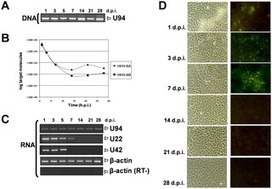Caselli E, Zatelli MC, Rizzo R, Benedetti S, Martorelli D, et al. (2012) Virologic and Immunologic Evidence Supporting an Association between HHV-6 and Hashimoto's Thyroiditis. PLoS Pathog 8(10): e1002951. doi:10.1371/journal.ppat.1002951
Hashimoto's thyroiditis (HT) is the most common of all thyroid diseases and is characterized by abundant lymphocyte infiltrate and thyroid impairment, caused by various cell- and antibody-mediated immune processes. Viral infections have been suggested as possible environmental triggers, but conclusive data are not available. We analyzed the presence and transcriptional state of human herpesvirus 6 (HHV-6) in thyroid fine needle aspirates (FNA) and peripheral blood mononuclear cells (PBMCs) from 34 HT patients and 28 controls, showing that HHV-6 DNA prevalence (82% vs. 10%, p≤0.001) and viral load were significantly increased in FNA from HT patients, and thyrocytes from HT FNA displayed a 100-fold higher HHV-6 DNA load compared to infiltrating lymphocytes. In addition, while HHV-6 was strictly latent in positive samples from controls, a low grade acute infection was detected in HT samples. HHV-6 variant characterization was carried out in 10 HT FNA samples, determining that all specimens harbored HHV-6 Variant A.
The tropism of HHV-6 for thyroid cells was verified by infection of Nthy-ori3-1, a thyroid follicular epithelial cell line, showing that thyrocytes are permissive to HHV-6 replication, which induces de novo expression of HLA class II antigens. Furthermore, HHV-6-infected Nthy-ori3-1 cells become targets for NK-mediated killing, NK cells from HT patients show a significantly more efficient killing of HHV-6 infected thyroid cells than healthy controls, and HT patients have increased T-cell responses to HHV-6 U94 protein, associated to viral latency. These observations suggest a potential role for HHV-6 (possibly variant A) in the development or triggering of HT.



 Your new post is loading...
Your new post is loading...







